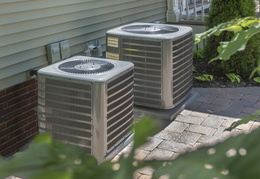
One of the best friends your house can have is central air conditioning in Tampa, FL for the hot summers. You only have to make an adjustment to the thermostat, and cool and refreshing air begins to move through the ducts to the rooms. Easy and convenient—and hard to imagine getting through a summer without one.
The type of central air conditioner that your home probably uses is called a split system. You may have heard this term used, or heard about an alternative called mini splits, and wondered what those terms specifically mean. We’re going to give you a basic rundown on split systems and what makes other ACs different.
The Split System Air Conditioner
Does your AC have an outside cabinet and an indoor cabinet? Then you have a split system. The name comes from the two separate elements, one outdoors and one indoors, that allows the air conditioner to remove heat from the interior of the house and exhaust it outside.
The exterior cabinet of a split system AC is called the condenser. It houses the compressor, where refrigerant is put under pressure so it will circulate through the system, an exhaust fan, and a condenser coil where the hot refrigerant releases heat to the outside.
Copper refrigerant lines carry the refrigerant indoors to the second half of the system. The indoor cabinet contains the evaporator coil and an air handler. The air handler sends air past the evaporator coil to be cooled off and then into the ductwork where it will travel to the rooms.
What Are Alternatives to Split System ACs?
Split system air conditioning systems are the most common cooling systems found in homes. But there are other types of air conditioners: what are these systems and what sets them apart from a split system air conditioner?
- Window AC units: You’re familiar with these. They aren’t split into two units because they hang half in and half out of the house through a window. Window ACs are useful for apartment rooms, but they’re rarely beneficial for a house—they don’t have the cooling power and they block windows.
- Ductless mini splits: These are types of heat pumps (which means they work in both cooling and heating mode) with a similar split configuration of indoor and outdoor units. What makes mini splits different is the mini part—they use multiple smaller indoor units to send cooling (or heating) directly into rooms. These mini air handler/refrigerant coils are mounted on the exterior walls of rooms and connect to the outdoor unit. Ductless systems are often used for homes that lack space for ductwork or in new home construction.
- Packaged units: This is the true opposite of a split system AC because it only has outdoor components. Both sets of coils, as well as the fans, are inside a single outdoor cabinet, which connects directly into the ductwork of the house. Packaged units are uncommon for homes, but they are the dominant type of cooling system for larger buildings and commercial facilities. These are the HVAC units you see on top of buildings.
The A/C Guy of Tampa Bay Inc. serves our Tampa Bay family with integrity and honor. Call us for your home cooling needs.

